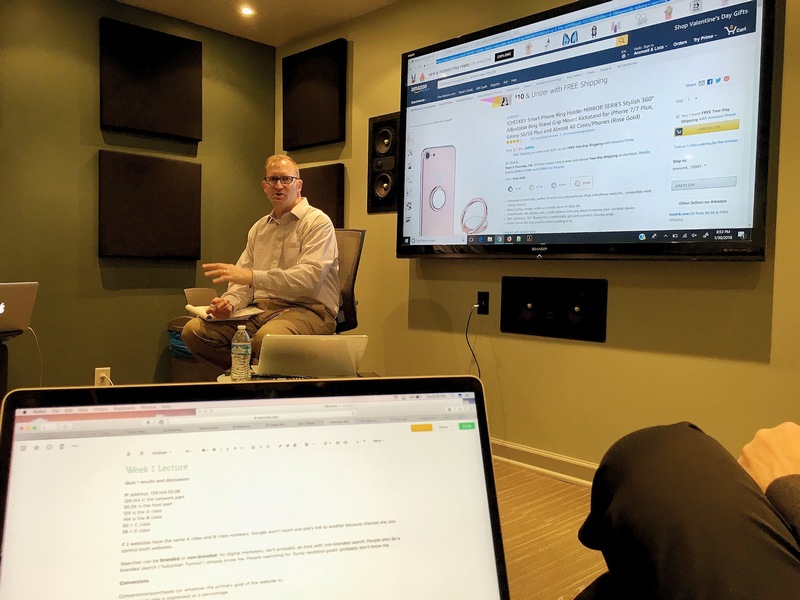Do you have what it takes to get through a digital marketing course?
[Note from Ross: This is part of a series of blog posts by Lindsay, a student in our MKT513 Digital Marketing Masters Class. She’s documenting what the course is like from the student’s perspective. She received a partial scholarship in exchange for her blog posts about the course.]
I’ve done a lot of things in my life, but it’s safe to say that when I die, I’ll be best remembered as ‘that blogger.’ In fact, if the words ‘She blogged’ are carved onto my headstone, I have no doubt that those who visit my grave will read it and nod silently in affirmation before either wiping away a tear or spitting.
For better or worse, my blog has become my profession and my public identity since I started it 12 years ago and I don’t see that changing any time soon — but like any blogger worth their pageviews, I have one well-hidden and incredibly shameful secret….
I know nothing about SEO.
Or affiliate links. Or conversion rates. Or analytics. Most professional bloggers live and die by this stuff — As for me, I’m completely clueless. I’ve tried watching videos and reading articles on these topics, but they make about as much sense to me as an Instant Pot manual written in Polish.
I know my lack of understanding has been holding me back as a blogger and website owner, but I could never seem to come up with a realistic solution to the problem– at least until last week.
That’s when I came across a video on Facebook, offering a scholarship to a Digital Marketing Masters Class here in Nashville. The 14-week digital marketing course would cover all the latest terms and techniques that have eluded me for years. I took a deep breath and applied — and I got the scholarship! And that’s why you’re reading these words right now. So meta, right?
It turns out digital marketing strategies appeal to all kinds of people.
I was really nervous about attending my first class this week — I figured everyone else in the room would be tech wizards and marketing gurus and social media experts, and that they’d all roll their eyes when I stumbled in.
Instead, I entered a room filled with people of all ages and stages, from digital marketing beginners like me to people who’ve worked in the field for years and are continuing their education. Relief!
I was also worried about whether I had the attention span for a three-hour class — I mean, I have trouble sitting still through a Pixar movie. Fortunately, our instructor, Ross Jones, has turned the class into an extended discussion of the subject matter.
Rather than lecturing us while we frantically took notes, there was a lot of back and forth between all of us about the material and how it applied to real-life scenarios, and the environment was comfortable enough that we could also ask questions about how to apply what we were learning to our careers. The time flew by.
Covering the basics of digital marketing
We quickly ran through basic technical terms so that we’d all be on the same page. I was excited to discover that I already understand a whole lot more than I thought I did — I just didn’t necessarily know the proper terminology. For example, I learned the difference between server-side programming languages (like Perl and and Java) and client-side programming languages (HTML, Javascript) and why each language is important. I’d never known the difference before. D’oh!
Another aha moment for me was our discussion of conversions and how to find a conversion rate. I always tried to nod knowledgeably when the subject of conversions came up among my colleagues, but inside I was totally dazed and confused. Not anymore!
I now know that conversion is simply the main thing you want someone to do when they visit your site — so for a site like Amazon, the conversion would be purchases. The conversion rate is the percentage of visitors who convert, which means that in Amazon’s case, the conversion rate would be the number of purchases divided by the number of site visitors.
Who knew it was all so simple?
Website traffic and where it comes from
We also spent time talking about the types of traffic a website can get, whether it’s direct traffic (when a URL is typed directly into a browser), referral traffic (traffic that comes from another site), or search traffic (traffic that comes from a Search Engine Results Page aka SERP) and how targeting these different types of traffic as a marketer could affect the site’s success.
Although the terminology we ran through was basic information for some, everyone got something out of it because we were continually bringing up real-life examples as we went through the material, and because Ross welcomed any questions that tied in to the topic under discussion. Since we all have different areas of expertise, it was interesting to hear the perspectives of other students in addition to that of our instructor.
We’ll dive much deeper into these topics and others as the weeks progress and I’m sure some areas will be more confusing to me than others — In our next class, we’re tackling the digital marketing aspects of web design, a subject that has always made me want to weep with frustration. Now, though, I’m actually excited about learning more. Stay tuned, and see you next week!
